Before I start with today’s post I send this huge hug and a million ‘Thanks’ to my dear mom who made these posts happen. If not for her guidance and enthusiasm, I would have never even attempted in noting these down. Thanks Mom 🙂
I must warn you that this is a lengthy post and I hope you enjoy reading it…
After writing about Deepasthamba Poojay, I am here with yet another pooja that is performed in Madhwa homes – Varalakshmi Vrata / Varalakshmi pooja.
This Pooja is also performed by other communities but our differes from the rest in several aspects. These rituals are those that are performed in my house as instructed by my grandfather and these procedures may vary within our community as well.
Varalakshmi Vratha is performed in the Kannada month of Sravana maasa [July- August] on the Friday following the full moon/ on the full moon day – Powrnami.
This pooja is done by married women for the well being for the members of her family especially her husband and also to seek the seek the blessing of Goddess Sri Lakshmi to bestow her family with health and wealth.
This vratha is initiated by the Mother -in-law to her daughter in law. The initiation day has to be Powrnami[full moon ],Friday and in sravana maasa. When all the three criteria is fulfilled that is called Thumbi Baradhu.This sort of combo occurs only once in a while and not every year. So the new bride has to wait till the day comes when all the 3 criteria occurs together.
When all the 3 occur together, the MIL initiates the couple into the pooja and after that, only the lady will perform the pooja every year.
The first year, the couple are seated and a Sankalpa is made praying that the pooja has been started and must continue every year without any hitches. Usually a priest is called upon to do this ceremony.New dresses for the couple are gifted from the brides side.
Every year mom goes to grandpa’s place to perform this pooja. Until a few years ago, I was never able to attend it but when Lil Dude was born, we accompanied mom to grandpas place and I took that opportunity to record the pooja as performed by my dear grandpa.
Usually priests are invited to perform the Varalakshmi Pooja but grandpa is very well versed in all the Poojas that he guides the women in the pooja.
The preparation for the pooja starts a day before itself. The women who are doing the pooja , take rad bath in the morning and wash a 9 yard sarie that is to be worn for the pooja and maru pooja and puts it out to dry. Once the saries are dry, she fold it and keeps it in the Pooa room / a place where no one else will touch it. This is called Madi Seeray [ Pure / sanctified sarie].It is only after she keeps the dried sari safely, that she even take coffee / breakfast.
On the day of the Vratha, the women take head bath and do the pooja while fasting. Some people don’t even have their morning cup of coffee!
Early in the morning the front of the house is sprinkled with water and rangoli is drawn. Kemman rangoli is a must.That is the one on the first pic. Red color lines are made with by mixing a sort of red colored mud with water and drawing rangoli with it.
The Pooja room has been cleaned the previous day . Now the lamps are lit and kept ready to be palces as soon as the Goddess is seated.
The Gajavasthara, Pooja items like kumkum, turmeric powder, fruits, sacred thread, moradha bayana, flowers,the altar are all readied.
[For Moradha Bagina / Moradha Bayana –‘Mora‘ is a flat plate made of bamboo.It is placed as a
pair.Turmeric is smeared on it and vermilion lines are drawn on it.On
one ‘Mora’ a dress material-Saree and blouse, bangles, mirror, comb ,
kajal, kumkum[vermilion], turmeric ,small packs of rice,rice
flour,jaggery,moong dhal,toor dhal,silver toe-ring,gold nose pin,a ‘mangalya‘[A
sacred pendent that is worn by married women],money are kept.Any other
thing which is considered sacred is can also be kept along with these
things.This is closed with the other ‘mora’.]
The pooja starts before the Raghu Kaala [ inauspicious time] and there are other poojas that are performed before the actual Varalakshmi pooja.
1.Saligrama Poojay – Saligrama is a fossilized stone that is considered to be very auspicious and said to represent Lord Vishnu. The Saligrama is said to be collected from the banks / river beds of sacred rivers.
It is passed down through generations or given as Daana [ sacred donation].The Saligrama is usually kept in the Pooja room in a closed box / container. Only men are allowed to perform pooja to the Saligrama. They too must follow certain procedures / rituals when performing the pooja for the Saligrama.
The first pooja done on this day is the Saligrama poojay. If a priest is called in for the pooja, her performs it.Here my grandpa does this pooja.
2.Tulasi Pooja – The tulasi plant is considered to be very sacred and pooja is performed to the palnt. Everyday, women wash the place where the planter is kept and draw rangoli in front if it.Theyoffer water and kumkum and turmeric to the tulasi plant as soon as they have their morning bath and only after that do they have their breakfast. Even till the present day, mom and grandmom follow this ritual!
So on the Varalakshmi pooja day,Rangoli is drawn in front and the tulasi planter [Tulasi Kattay] is adorned with mango leaf garland.It is worshiped with kum kum , turmeric, gajavasthara, flowers and flower garland.
3.Yamuna Poojay – This pooja is done to invoke the blessings of Yamuna Devi.
A woodden plank is placed beside the main altar.Rangoli is drawn on the plank.A plantain leaf is kept over it.Rice is spread over the rice.
A small silver/ brass pot called kalasa is filled with water and kept on the leaf with rice..The pot is first painted with slaked lime and kumkum dots are kept on the sides.
Mango leaves are places on the rim and on it a coconut is placed. Then the face of Yamuna Devi with all decorations like ear rings, chains ,nose pins etc is kept and tied to the coconut.
Pooja is performed with kumkum, turmeric, gajavasthara[cotton garland], garlands, flowers.This pooja is done near the main altar.Sacred chants/ Mantras / Slokas are recited.
4.Ganesan Poojay– The blessings of Lord Ganesha is invoked with Mantras and slokas and the main pooja starts.
The altar for the Varalakshmi pooja is prepared as seen below.A mirror is placed behind the altar .Rangoli is drawn and a plantain leaf is placed over it. Rice is spread over the plantain leaf. Small banana trees are tied to the posts on the sides. Mango leaf garland adorns the top of the altar.
For the main pooja too, the Deity is kept ready. A silver pot/ Kalasa is smeared with slaked lime and kumkum dots are places all around. Inside the pot the following are placed -Rice , Lemon, dry dates [Karjur Kaai], raisins, cardamom,sachets of kumkum and turmeric, coins, small silver and gold jewellery. If the pocket permits, the 9 gems / nava rathnas can also be placed inside.
Mango leaves are placed on the rim and a coconut is placed on top of the mango leaves.A silver rod is tied through the top part of the coconut and on either side of the rod, bangles, bicholay ,Karumani[A small bangle like thing made out of palm leaf, karumani is the black beads that married women wear].The face of Lakshmi is tied to the coconut and she is decorated with necklaces, ear rinds, flower garlands, a flowery plait etc.
Before this pooja starts, a cup of rice and a piece of jaggery is
placed on the door step. Foot marks are drawn in rangoli powder symbolising the
Goddess walking towards the house from he gate into the pooja room.
The whole set up – the pot with the Goddess is
carried out side the house. It is like inviting her home. So the women
who do the pooja carry the idol near the gate and the other women offer
her kum kum and turmeric . Aarathi is taken and she is carried towards
the house.
The lady carrying the Goddess walks beside these foot prints and walks towards the front door.
The lady carrying the Goddess, tips the cup with the rice and jaggery with her hands that are holding the Goddess. It symbolizes the Goddess entering the house.
The pooja is also done for the thread that is to be tied on the wrist of the women performing the pooja and for those who attend it as well.
Meanwhile, neivedhya [ offerings] get prepped. It is usually done in the traditional style using iron stoves fired with coal and fire wood. The food tastes so good when it is cooked in this way.
The dishes are offered on a platain leaf kept over a large plate. Then sodal aarathi is done followed by mangala aarathi / Kalpoora / Camphor Aarathi.
Then urutani is done for the ladies.The girl/women is seated on a wooden
plank and her legs are smeared with turmeric paste and vermilion lines
outlining her feet are drawn .She is given a set of betel leaves,betel
nuts,fruits and coconut along with kumkum[vermilion].The sacred thread is tied to her hands.
That is my mom doing the urutani for my grandmom and me and lil angel getting the sacred thread ..
Then all of them pray to Her once again .
Then the story of how this pooja came into being is recited / read out. Grandpa does this part so well that you could listen to him all day!
According to the legends, Goddess Parvathi asks her Consort Lord Shiva a simple question – Which is the best /most auspicious pooja ?
Lord Shiva replies by telling the story about a lady called Charumathi who dreamt that this pooja should be performed and she did it on waking up.
And then he outlines the good things that will happen when this pooja is performed etc. It is in a sloka- story form.
The brunch follows which is actually a full fledged lunch with 2 or more sweets, 2 vegetable curries, pappad, bonda, flavored rice pickles, lentil salads called kosambari, rice , sambar, rasam, curd and payasa/ kheer.
The women who have been fasting from the morning [and they are the ones who performed the pooja] will be seated first for lunch / brunch and after they start the meal , the others will join in.
The pooja room is left as such for the rest of the day. Thamboola [Betel leaves, betel nuts, fruits, money,coconut] is offered by the lady of the house to all who attended the pooja.
In the evening lamps and incense sticks are lit.
The next morning, all those who did the pooja will have to do a Maru Poojay. This is a shorter version of the main pooja and done in a short period of time.
After this pooja the kalasa / the pot with Goddess is moved away slightly symbolizing the end of the pooja.
In the evening, before lighting the lamps, both the kalasas, are placed inside the container used to keep rice. It is left as such over night.
The next morning, they are removed from the container and wiped with a cloth and kept aside safely till the following year. The coconut used in the kalasa is generally used for making kheer / burfi/ any other dessert preparation and not to be ised in savory preparationsl like sambar / chutney.
This is how Varalakshmi Vratha Pooja is dome in my family. The rituals and procedures may vary from family to family.
Take a look at all that was served so far on The Buffet On Table…
Check out the Blogging Marathon page for the other Blogging Marathoners doing BM# 56
Bon Appetit…

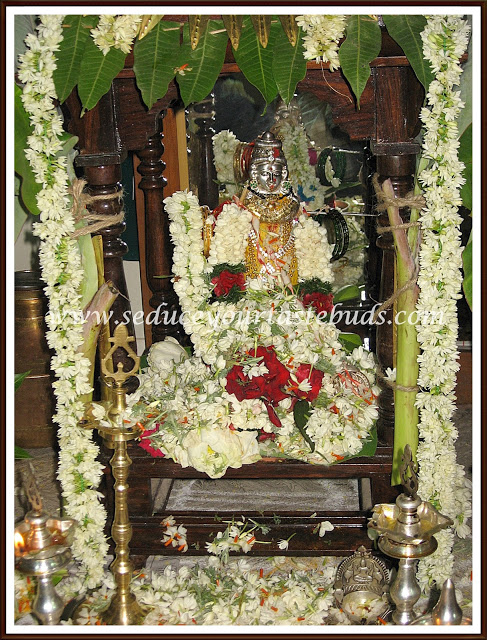

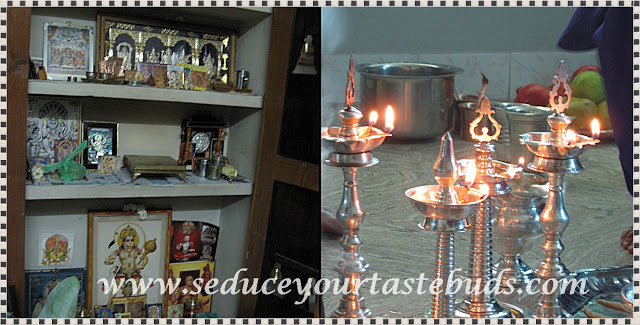

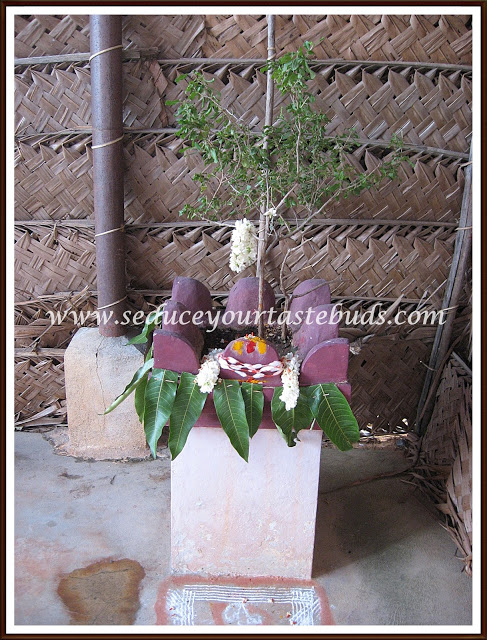
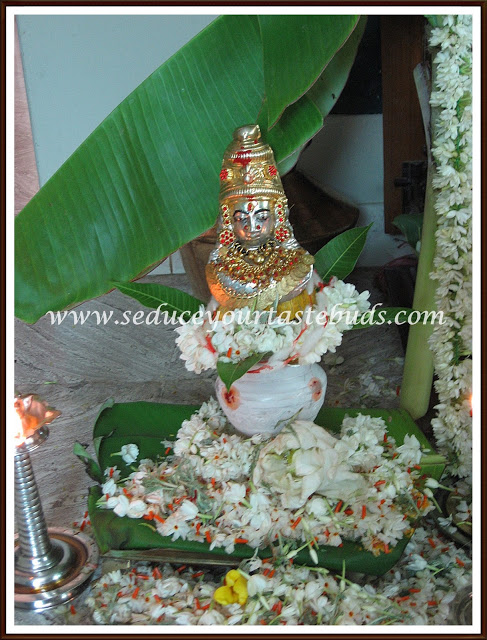
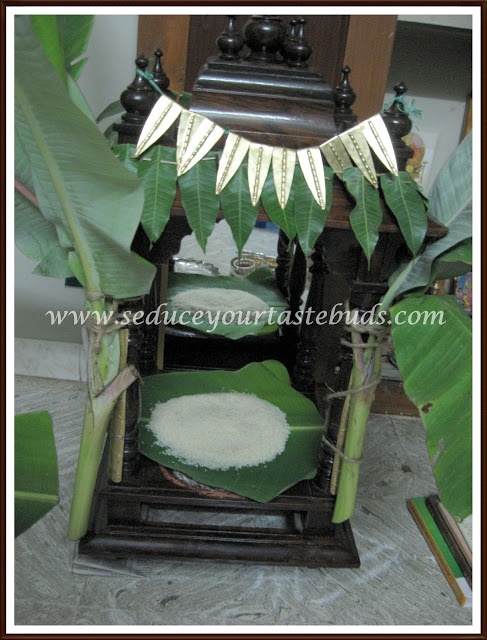

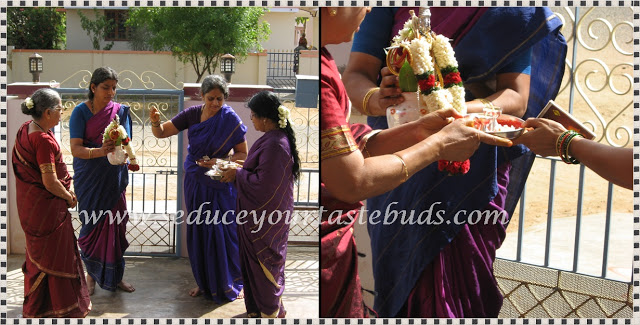
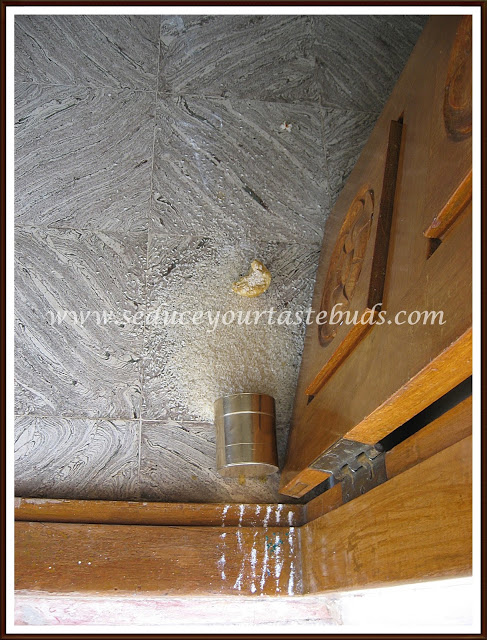
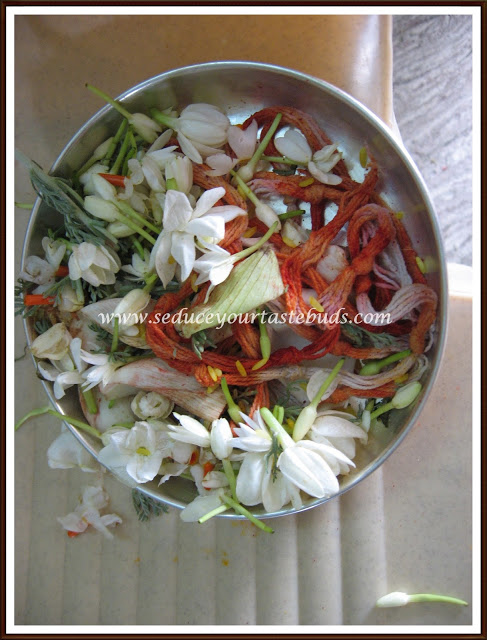

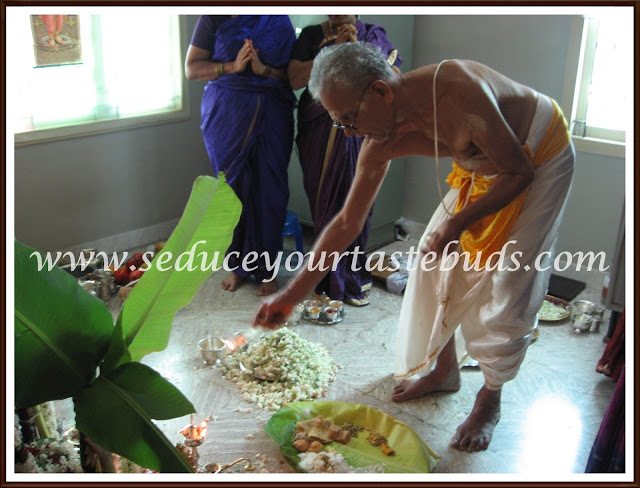
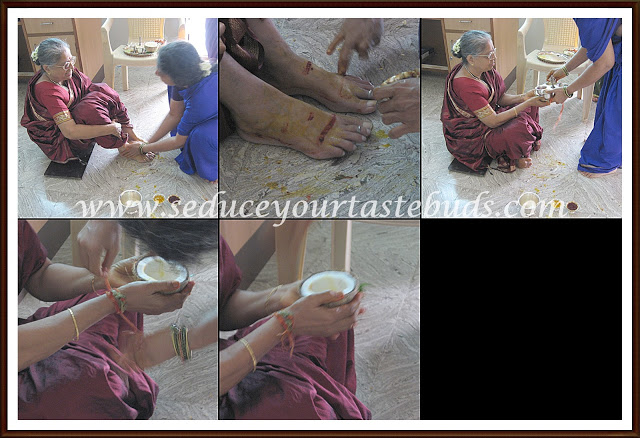
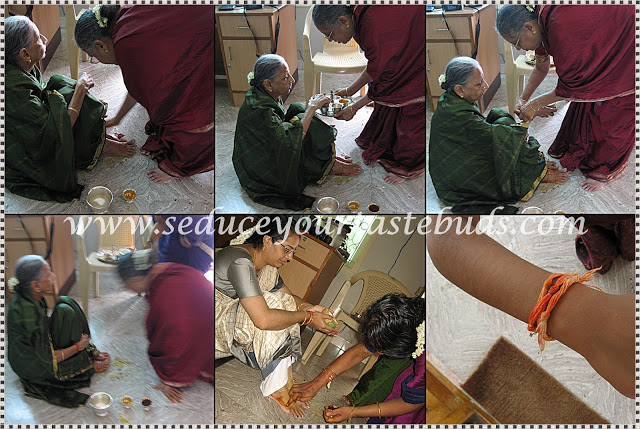
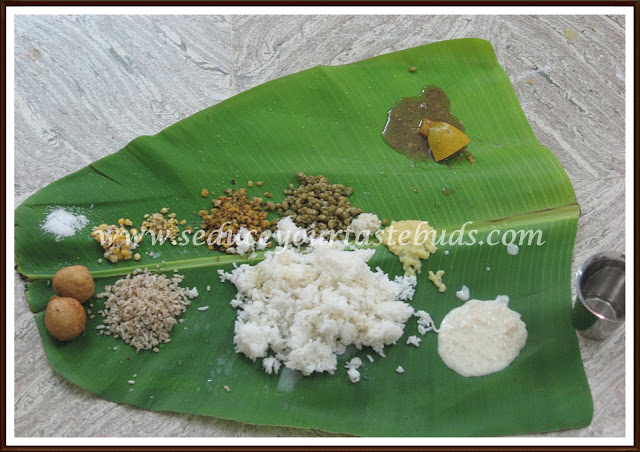
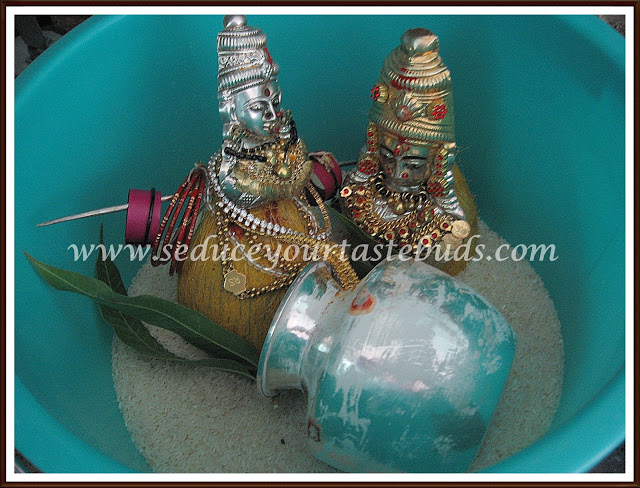
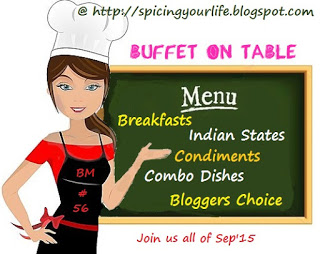

We pretty much follow the same procedure. Loved you step by step clicks. I rely on the DVD. Two years back I got all the pooja dvds and follow the same.
We being Madhwas follow the very same procedure as you,and pl let me know this year in 2020,as it falls on Dwadasi day,at what time we have to finish the Pooja.It is said that Paaranai for Dwadasi is after 6 a.m on 31.7.20. pl advise.We areMadhwa kannada Brahmins and for madi ,we also prepare food in kumuti,charcoal iron stove and firewood only.But nowadays,it seems impossible and we prepare on well cleaned gas stove only.Pl let me know the time of Pooja this year. I live in Trichy,Tamil nadu and I am 67 yrs old.
Sorry for the late reply mam. We are planning to start the pooja before Raghu kalam on friday . We can also do the pooja as soon as ekasi is over and then do the paaranay. Yes, nowadays it is very difficult to get the food cooked in kumutti / firewood,and like you said we too prepare in the stove only.
That's surely one detailed account of the Pooja PJ..so nicely documented..:)..thanks to your Mom and yourself too for this wonderful post..
wow a very detailed procedure!!! you have written it sooo well…
This is a wonderful post and thanks for sharing. My paternal side the pooja is very lengthy but the procedure is slightly different. In my paternal grandma's house a priest use to be called to perform the pooja.
Such a detailed post and you explained it very well.Thanks for sharing this.
Good one, PJ. A detailed account of the procedure.
A another informative post, an added knowledge of different customs.
I have heard so much about this pooja from south bloggers but never knew what exactly is the ttradition.You have explained everything in detail.Hats off to your efforts.
Well written Pj, my next door aunty celebrates varalakshmi vratham in India, but never had a chance to participate in it.. Again an another beautiful post..
Amazing post about Varalakshmi vratam PJ. What we do is somewhat different from do. Loved reading about the poojas and traditions followed.
Beautiful post , very detailed one ! I had no clue about this pooja .
Wow PJ you really can write about festivities.
What do you do with the bagina?
Sirisha,we offer that to the married woman/ women who are invited home to take part in the pooja.This is done after the pooja is over or in the evening.